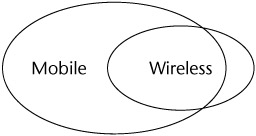Definition of Mobile and Wireless
The definition of mobile and wireless varies from person to person and organization to organization. In many cases, the terms mobile and wireless are used interchangeably, even though they are two different things. Let's start with the term mobile. Mobile is the ability to be on the move. A mobile device is anything that can be used on the move, ranging from laptops to mobile phones. As long as location is not fixed, it is considered mobile. Areas that are not included in our definition of mobile include remote offices, home offices, or home appliances. While these are definitely remote, they are not considered mobile.
Wireless refers to the transmission of voice and data over radio waves. It allows workers to communicate with enterprise data without requiring a physical connection to the network. Wireless devices include anything that uses a wireless network to either send or receive data. The wireless network itself can be accessed from mobile workers, as well as in fixed locations. Figure 1.1 depicts the relationship between mobile and wireless. As you can see, in most cases, wireless is a subset of mobile; but in many cases, an application can be mobile without being wireless.

Figure 1.1: Relationship between mobile and wireless.
For an application to be considered mobile or wireless, it must be tailored to the characteristics of the device that it runs on. Limited resources, low network bandwidth, and intermittent connectivity all factor into the proper design of these applications.
Wireless applications that are not mobile use fixed wireless networks. These are wireless networks that provide network access in a fixed environment. An example is a wireless local area network (WLAN) that is used to give desktops network access. Many businesses as well as home users are installing WLAN technology to avoid having to install network cables throughout their buildings. Another example is network access via satellites in remote locations where there are no other connectivity options.
On the other side, we have mobile applications that are not wireless. There are many examples where this is the case. Any application that can be used on the move and that does not have wireless connectivity fits into this category. This includes many laptop and personal digital assistant (PDA) applications. Until only a few years ago, it was actually rare to have wireless data access for mobile devices. For these mobile applications, data is often synchronized using a fixed connection and stored on the device for use at a later time. It is worthwhile to note that even though these applications do not require wireless connectivity, they can often benefit from it when it is available. A sizeable portion of this book is dedicated to looking at these types of applications, which are referred to as smart client applications.
Now that we have defined mobile and wireless, it is time to look at some of the areas in which mobile applications are being deployed. Similar to the terms mobile and wireless, there is often confusion around the terms m-commerce and m-business.
|
|
EAN: 2147483647
Pages: 148
- Chapter III Two Models of Online Patronage: Why Do Consumers Shop on the Internet?
- Chapter X Converting Browsers to Buyers: Key Considerations in Designing Business-to-Consumer Web Sites
- Chapter XI User Satisfaction with Web Portals: An Empirical Study
- Chapter XIV Product Catalog and Shopping Cart Effective Design
- Chapter XVI Turning Web Surfers into Loyal Customers: Cognitive Lock-In Through Interface Design and Web Site Usability